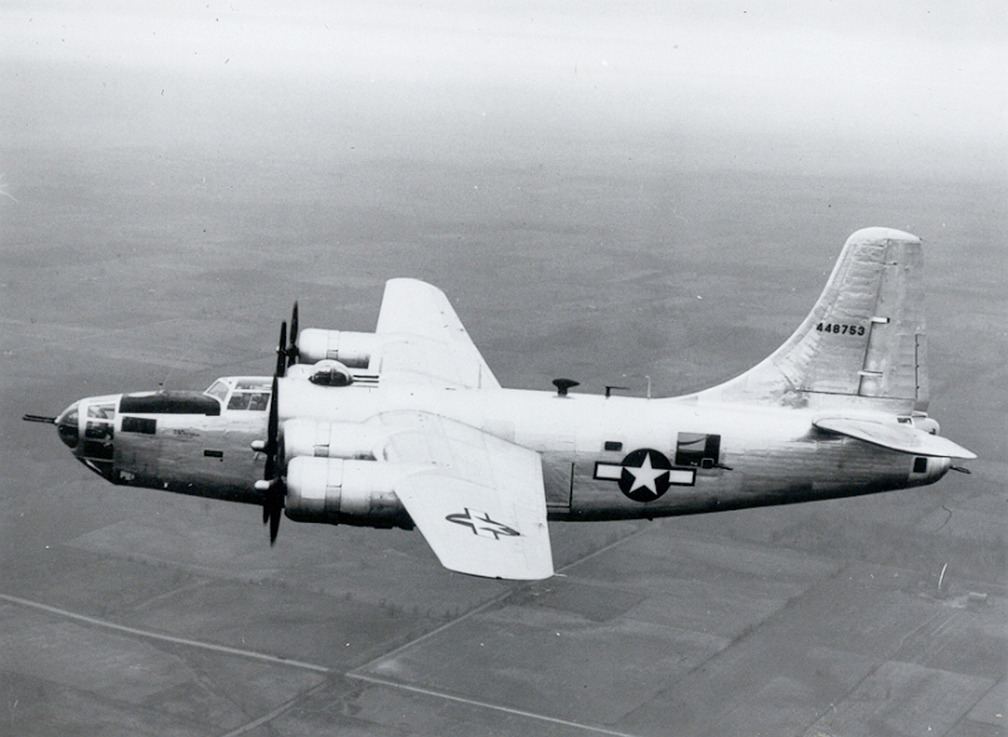History
To understand how the B-24N came about, we need to go back to 1942-1943, when the B-24 was already one of America’s most famous heavy bombers, instantly recognizable by its twin tail, like the B-25 Mitchell. The Liberator’s tailplane used two large oval vertical stabilizers mounted at each end of the horizontal stabilizer. Yet as early as 1942, USAAF officials believed that handling and stability could be further improved with a single vertical fin.
In early 1943, Ford sought to test this theory by modifying a B-24D-40-CO (serial 42-40234) with a single fin and rudder borrowed from a Douglas B-23 Dragon. This experimental aircraft, unofficially dubbed the B-24ST (“Single Tail”), made its first flight from Ford’s Willow Run plant in Michigan on March 6, 1943. Tests showed it to be more stable and easier to handle than standard Liberators.
Encouraged by these results, Ford developed a new vertical tail design and paired it with a horizontal stabilizer adapted from the Douglas C-54 Skymaster. Because the new tail required fuselage changes, the B-24ST’s fuselage was replaced, and it was fitted with more powerful Pratt & Whitney R-1830-75 turbosupercharged engines, each rated at 1,350 hp for takeoff. This new version was redesignated XB-24K and would serve as the direct basis for both the B-24N and the PB4Y-2.
Transferred to Eglin Army Air Field, Florida, the XB-24K first flew on September 9, 1943. It demonstrated superior stability and handling compared to twin-tail B-24s, and the single fin gave tail, waist, ball, and top gunners a wider field of fire. Thanks to its new engines, the XB-24K was 11 mph faster than standard Liberators and had a significantly better climb rate.
Convinced by the results, the USAAF decided in April 1944 that all future Liberators would adopt the single-tail layout, starting with a new production model, the B-24N. This version would retain the R-1830-75 engines and incorporate a streamlined, Sperry-built Emerson Model 128 nose turret, which had been tested on a modified B-24G. The Emerson 128 reduced airflow buffeting and improved formation flying performance compared to earlier blunt nose turrets, while also giving the bombardier and navigator much better visibility. At the rear, the B-24N was equipped with lighter A-6D tail turrets built by Southern Aircraft Corporation.
An order for 5,168 B-24Ns was placed, including one prototype (XB-24N) and seven pre-production aircraft for operational testing. The prototype (serial 44-48753) was completed and delivered to the USAAF on November 24, 1944, making its first flights from Wright Field before moving to Eglin for evaluation. Although deployment to the Pacific was briefly considered, it never occurred. The first pre-production B-24N was delivered on May 30, 1945, but by the next day, Ford’s Liberator production line had closed.
As the war drew to a close, B-24N crews were reassigned, many transitioning to the B-32 Dominator, and the program was cancelled. All eight completed B-24Ns were soon scrapped, as the superior B-29 Superfortress dominated Pacific operations and the planned invasion of Japan was called off.
Although the B-24N never saw combat, its single-tail configuration and turret innovations influenced later designs, most notably the PB4Y-2 Privateer, which served well into the postwar years with the US Navy.








